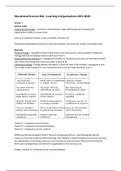Class notes
Lecture notes slides take-away messages LiO
- Course
- Institution
Summary of the lectures for LiO with the most important models/figures from the slides. Each paper is also summarized into a core message of 1 to 2 sentences. This will help you to understand the most improtant ideas in the papers!
[Show more]



